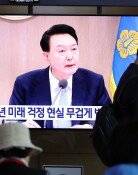A closer look at evacuation practice of U.S. civilians in Korea
A closer look at evacuation practice of U.S. civilians in Korea
Posted January. 05, 2017 07:13,
Updated January. 05, 2017 07:21

CNN accompanied the evacuation exercise, which continued through early November in 2016, and finally published Tuesday an exclusive story of the days in military with a headline “How to escape from Kim Jong Un.” A noncombatant evacuation exercise has been an annual event of U.S. forces in Korea. However, escorting civilians on helicopters to Okinawa in Japan has never simulated since 2010, showing that the U.S. is more worried about North Korea’s progress in nuclear power.
CNN published the story of evacuation exercise after it was completed two months ago amid increasing tensions between the U.S. and North Korea. North Korean leader Kim Jong Un showcased his nation's prowess in nuclear and missile capabilities in a new year’s speech. In response, U.S. President-elect Donald Trump criticized North Korea. “Kim Jong Un officially declared that the U.S. is its enemy. With all the rhetoric that comes out of North Korea, of course we have to prepare for the worst case scenario,” said Justin Sturn, a non-combatant evacuation planner.
U.S. civilians, carrying already packed bags, left their home after receiving a noncombatant evacuation order. Individuals were permitted to bring about 27.2 kg of personal stuff each. “The U.S. forces recommend families of serviceman or people in employment of public agency prepare a bag packed with canned foods and sleeping bag. We also have an emergency bag at home,” said Nicholle Martinez who was participating in the drill.
People received identity bracelets at a control center. The security screening required registration of pets. Children were instructed how to use chemical protective mask. Some people complained that the process is too lengthy and complex. In response, Col. Lance Calvert said, “During wartime, tens of thousands of civilians must leave over a period of five to seven days. Trains, buses or commercial transportation systems are much more efficient.”
People arrived at Camp Humphreys in Pyeongtaek, Gyeonggi Province by bus. They were then taken to Chinook helicopters, sitting on asphalt. Military officials said they had mixed feelings whenever boarding a helicopter. “The aim of the drill isn't only to try to give relatives a realistic practice run. The military also considers the mental aptitude of a soldier. The last thing you want is your soldier thinking about his family," said Capt. Jimmy Sheehan.
After taking off, the helicopters landed in Daegu. People spent a night in lodging in Camp Walker. The next morning, at 5 a.m., they were taken to Gimhae Air Base of Korean forces. They were then led to a US Air Force C-130 Hercules transport plane, heading to Japan. The air was chilly on the plane, people stayed closer to each other and fell asleep. After landing in a U.S. base in Okinawa, Japan, they returned to South Korea. If an evacuation were real, they would be escorted to the U.S.
Eun-A Cho achim@donga.com
Headline News
- Israel prepares for retaliation against Iran
- Samsung reclaims top spot, surpassing Apple in smartphone market
- 77% of Koreans in 20s and 30s are 'Kangaroo Tribe' due to job crisis
- KBO referees embroiled in controversy over ABS decision concealment
- Inflation, oil price surge put double shock on global economy






